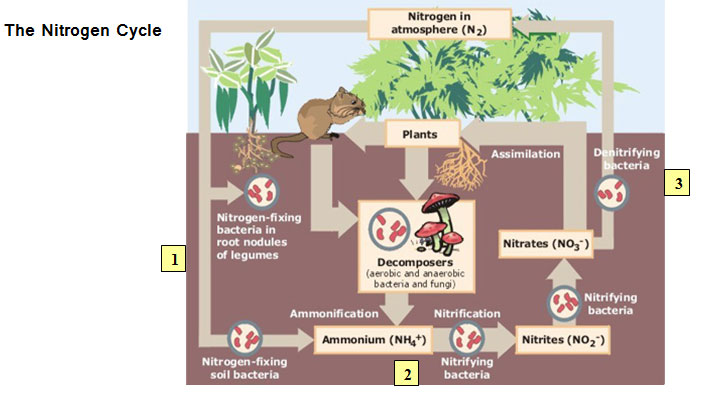 Source: Nitrogen Cycle, EPA, Wikimedia Commons
Source: Nitrogen Cycle, EPA, Wikimedia Commons
1. Bacteria and the Nitrogen Cycle:
Life on earth would stop if it weren't for bacteria! Even though they are tiny, they play an important role for maintaining balance on the earth. For example, plants use nutrients in the soil, animals eat the plants, wastes are eliminated from the animals, the waste becomes soil, and the cycle continues. Bacteria are essential in cycling the nutrients back into the soil for plants to use, and cycling nitrogen back into the atmosphere.
Nitrogen is found everywhere in the world including animal waste, the atmosphere, and decaying matter. Nitrogen is needed for all kinds of things including making amino acids, proteins, and genetic material. Nitrogen is the most abundant gas in the atmosphere and plants love it. However, nitrogen has to be in a certain form so organisms will be able to use it. Here's where bacteria come into the picture! Look at the diagram and see how bacteria help put nitrogen in a usable form for other organisms.
 Source: Nitrogen Cycle, EPA, Wikimedia Commons
Source: Nitrogen Cycle, EPA, Wikimedia Commons
Step 1: Nitrogen-fixing bacteria can be found in the soils and in the roots of certain plants. Plants can't use the nitrogen like it is. The bacteria change free nitrogen into substances that plants can use.
Step 2: When that process is finished, some nitrogen is converted into nitrates, nitrites, and ammonia. Plants can use these substances. When the plants become food, the nitrogen can be used by animals.
Step 3: Even though plants need nitrogen, too much nitrogen in the soil can be a bad thing. Just as there are nitrogen-fixing bacteria, some bacteria denitrify the soil to keep the nitrogen in balance. These bacteria take the nitrogen compounds and convert them to nitrogen gas. Then that nitrogen gas is returned back into the atmosphere!
Keeping this cycle in balance really depends on bacteria!
2. Bacteria as Decomposers:
Have you ever seen a dead mammoth lying around anywhere? Why not? North America had thousands of mammoths 20,000 years ago. Where did all of those bodies go? When living things die, bacteria and other organism, called decomposers, break down the tissues into smaller substances. Eventually, these nutrients are available to other organisms.
As you can see, bacteria maintain homeostasis in an ecosystem by decomposing dead organisms so that the nutrients can continue to be recycled!
3. Nitrogen and Digestion:
Another example of how bacteria maintain balance is its presence in the digestive system of certain animals.
Your body has millions of beneficial bacteria that live in your intestines. If they are there, they compete with other microorganisms and prevent 'bad' bacteria from reproducing and making you sick. Lactobacillus acidophilus helps to produce vitamin K and will also help your body digest dairy products. Bacteria, such as E. coli, live in the intestines of animals and people, helping them digest food.
There are animals called ruminants (cows, goats, and deer) that depend on E.coli bacteria to digest their food. Ruminants have a special stomach (rumen) that stores uneaten grasses, like hay. Billions of these bacteria live in the animal's rumens where they break down grass and hay into nutrients the animal can absorb into the bloodstream. Without the bacteria, these types of animals would not get their nutrition!